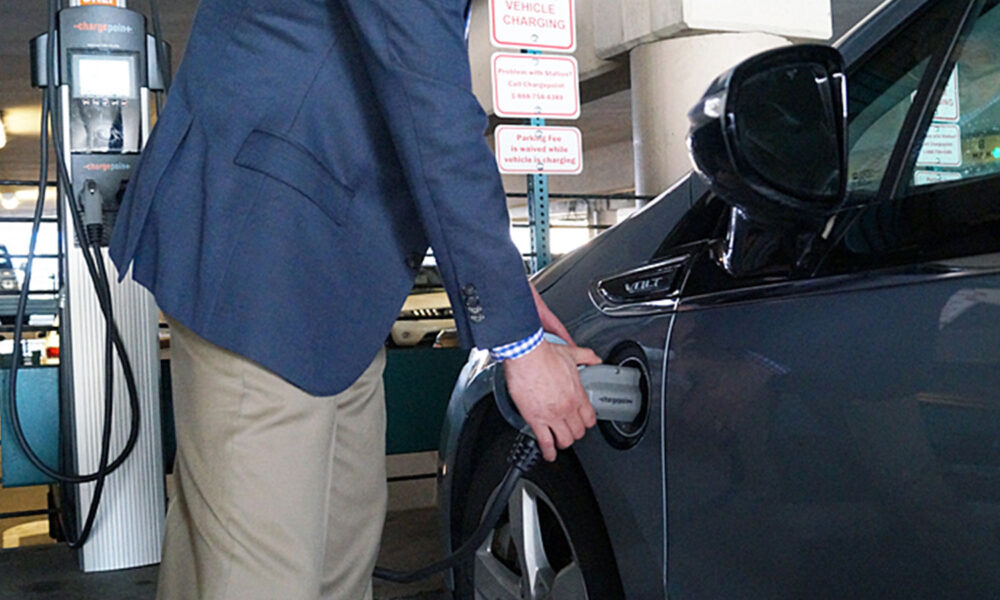In a surprise announcement, Senate Democrats unveiled a reconciliation bill, the Inflation Reduction Act of 2022, which could help reduce heat-trapping emissions by roughly 40% by 2030, a significant step toward our climate goals. As part of the climate-focused changes, this bill includes significant changes to the electric vehicle (EV) tax credit. If passed, it could help accelerate the transition from gasoline to electricity with $7,500 for qualifying new EVs and a $4,000 credit for used EVs.
Electric vehicles are key to reducing global warming emissions
Why is this tax credit a big deal? Because transportation is the largest source of global warming emissions in the US and passenger cars, trucks, and SUVs produce the majority of transportation emissions. Limiting climate change will require the rapid reduction in these emissions from the vehicles we drive. Making EVs more affordable and even cheaper than gasoline options will make it easier for car buyers to make the switch. And since EVs on average cut global warming emissions roughly in half, this switch to electric cars, trucks, and SUVs can put us on the path to meeting US climate goals.

What’s new in this version of the EV tax credit?
A lot. While the maximum credit of $7,500 for new EVs is the same, many of the details have changed. Here are the key changes we know about so far:
- The existing credit was capped and phased out after a manufacturer had sold 200,000 EVs in the US, which had the effect of penalizing carmakers that had moved the quickest in offering EVs. The new credit is not capped by automaker and is available through 2032. This means that this new credit will be available to buyers of qualifying Tesla and General Motors vehicles, manufacturers who currently are ineligible.
- While all manufacturers are now eligible, not all vehicles will be. Cars with a manufacturer’s suggested retail price (MSRP) over $55,000 and vans, pickups, and SUV with a MSRP over $80,000 are not eligible for the tax credit. This means most EV models can get the credit , while excluding high-price luxury vehicles for which the tax credit is much less likely to influence the purchase decision.
- Requirements for qualifying for the credit have also changed, with vehicles complying with either critical mineral or battery component requirements eligible for $3,750 each or $7,500 if a vehicle meets both. In order to qualify, an increasing fraction of the materials and components need to be from North America (or from a free trade agreement country in the case of critical minerals).
- There is now an income cap on the tax credit. Joint filers need to have an adjusted gross income of less than $300,000 to be eligible to take the credit on their tax return ($150,000 for single filers).
- The credit is now assignable to a car dealer so that buyers can use the credit as part of their down payment or as cash back from the dealer. This could function like a “point-of-sale” rebate and would make it easier for many EV buyers as the tax credit will reduce the upfront cost of the EV. That’s different than the current EV tax credit that requires buyers to wait until filing their taxes in the following calendar year to receive the value of the EV credit. This assignment of the credit is also a potential solution for car buyers that have less than $7,500 tax liabilities as the EV credit can reduce one’s tax liability but is not refundable.
- Finally, this credit is no longer a “plug-in electric vehicle” tax credit. The credit is now a “clean vehicle” credit and includes hydrogen fuel cell electric vehicles (these vehicles were formerly included in another section of the tax code).
For the first time, a used clean vehicle tax credit
In addition to the revamped clean vehicle tax credit for new car purchases, the reconciliation bill also includes a credit for used clean vehicles, which is important to make sure lower-income drivers can still make the switch away from gasoline. Buyers of used EVs can get $4,000 or 30% of the sales price, whichever is lesser. There are also price and income caps tied to this credit. Many more vehicles are purchased used than new, so this provision could greatly increase access to clean vehicles.
Why an EV credit now?
It is clear we need to accelerate the transition to EVs over the next decade. Having smart policies in place will send the right signal to both buyers and automakers that EVs are the best choice. This tax credit isn’t the only policy needed; emissions regulations and policies that reduce the need for driving are also vital. However, this bill is a step in the right direction and will help reduce global warming emissions so that we can avoid the worst impacts of climate change.

